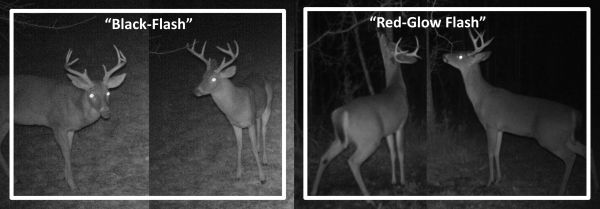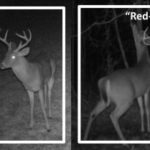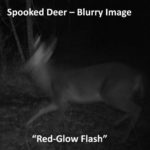
This past week I ran by the showroom of one of my favorite hunting-products companies that, fortunately for me, happens to be headquartered about a 20-minute drive from my home. My goal was to check out their new trail camera line in person and grab two or three of their latest “black-flash” cameras to replace some of my older antiquated “red-glow” flash (so-called “infrared”) models.
By antiquated, I mean cameras that I purchased fairly recently (within the past three or four years) but that are technically antiquated. I am gradually upgrading my entire working camera fleet to contain just two basic types of camera flash mode, “white strobe” flash and no-glow “black-flash.”
Although I still have and use a handful of residual cameras that use “red-glow” flash, they are relegated to specific non-critical sites and uses.
I well remember the evening several years ago when I tried out my very first so-called invisible IR (infrared) flash trail camera in the backyard. My excitement level was sky high, as the advertisements from all of the manufacturers had boasted about how the new IR flash technology made the camera invisible at night to game animals and humans.
Man, what a deal; this was going to be absolutely great, the ticket to big, mature bucks that sometimes become flash shy.
My new camera was armed and ready as I slowly strode past it in the dark, wanting to grab a few test shots to see how good the picture quality would be. Entering the camera’s detection zone, I suddenly slammed on the brakes, stared wide-eyed at the camera and thought to myself: “what the …?” The camera’s bank of IR LED (light-emitting diode) bulbs were visibly glowing red — not instantaneously as in a lightning-fast strobe fashion, but glowing for maybe a full second or longer.
I repeated the test multiple times to see if I had set up something up wrong, with the same result each and every time. I knew that if I could see the flash glowing red, so could every deer that walked by at night. The camera in question was one of the absolute top brands, so after calling the maker the next day, the “red-glow” issue was found to have nothing to do with quality.
It then became painfully obvious to me that the camera manufacturers were all stretching the truth a bit about just how stealthy the new IR flash cameras actually were at the time. Now granted, they did not pop a brilliant white flash into the eyes of an unsuspecting deer, but as I came to find out through extensive use, there was — in my opinion — an even worse result, as attention was being drawn to my cameras and deer were being spooked.
Subsequently, through the taking of several thousand nighttime trail cam photos over multiple years in the field using “red-glow” cameras, the long “red-glow” effect caused deer to almost always notice and focus in on the camera, and at times to bolt and shy away.
As a result, I often got photos of significantly blurred, moving subjects.
As I studied the technical side of the issue, I found that the frequent blurring was because camera imaging devices are less sensitive to red light, resulting in the camera shutter remaining open considerably longer than with a white flash. Any appreciable movement at all resulted in a blurred image.
I used them and still use white “strobe-flash” to great advantage in certain situations or set-ups, as it inherently produces crisp color images of moving animals at night in low light at greater distances.
One of the trade-offs is that regular flash eats through batteries faster than IR flash, but the result is worth the additional cost in locations where I need to image moving deer at night, such as in a funnel or alley-way that is 60 feet or more across.
White “strobe-flash” is particularly useful across narrow food plots and in food plot corners.
Now, let’s return our attention back to the subject of “no-glow, black-flash” trail cameras. The new camera models that use true “black-flash” technology are revolutionizing trail camera use.
My latest cameras use “black-flash” technology that has a full 50 feet of nighttime flash range. They are true no-flash, no-glow and no-light models, and are undetectable both to animals and humans.
An equally amazing feature of this particular camera model is its capability, at a one second “detection to trigger” speed, of providing up to 5 megapixel nighttime photo quality and up to 7.0 megapixel daytime color photo quality.
“Black-flash” camera size ranges from the traditional full-size units that use D-cell batteries on down to the new miniaturized versions small enough to use AA-cell batteries. One excellent feature of the models that use the smaller AA-cell batteries is the ability to upgrade to AA lithium batteries that are somewhat more expensive than the standard Energizer-type batteries but can better handle extreme cold temperatures and deliver much longer run times.
Whether you are using white “strobe-flash,” “red-glow” IR flash or “no-glow” IR flash, or maybe a combination of all three, recognize the inherent strengths and weaknesses of each technology and then play to their strength with your camera set-ups and locations.
Use white “strobe-flash” for distance and photo clarity, especially where you expect your photo subjects to be in motion.
Conversely, “red-glow” and “no-glow” IR flash is much more useful and appropriate where deer will tend to be closer to the camera and somewhat stationary, such as at a scrape or feeder site.
The “no-glow” technology will be particularly useful when you desire or need to use total stealth at a particular site.
I will report back with additional findings as I gain more experience with “black-flash” and gather more field data.




